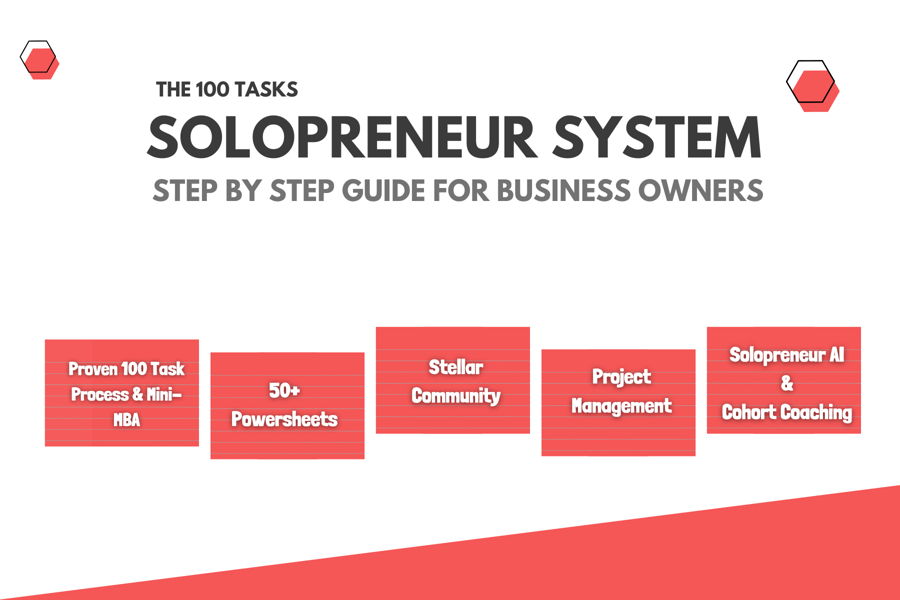Learn actionable strategies to scale your solopreneur business efficiently. From delegation to marketing, discover tips for sustainable growth.
Can you be both, a solopreneur and entrepreneur? Yes, absolutely! So, what is a solopreneur and what is the difference between solopreneurs and entrepreneurs?
Solopreneurs, meaning individuals who operate their businesses independently as a one-person operation, often handle all aspects of the venture single-handedly. An entrepreneur is someone who starts a business and takes on financial risks in the hope of profit.
Solopreneurs typically handle tasks such as product or service development, client acquisition, administrative duties, and financial management on their own. They are responsible for all aspects of the business, including planning, decision-making, marketing, sales, and operations.
The draw of the solopreneur lifestyle lies in the freedom and flexibility it offers. Solopreneurs have the autonomy to make their own decisions, set their own schedules, and pursue their passions.
They can also enjoy the direct benefits of their efforts, such as increased earnings and personal fulfillment. Additionally, solopreneurship allows individuals to have greater control over their work-life balance, enabling them to prioritize what matters most to them.
While solopreneurs may occasionally hire contractors or freelancers for specific projects, they primarily work alone and have full control over their businesses. This type of entrepreneurship offers flexibility and autonomy but also requires individuals to wear multiple hats and manage all aspects of their businesses single-handedly.
Learn how to be a successful solopreneur and scale your solopreneur business on your own terms with the 100 Tasks Solopreneur Course – a proven step-by-step process, all-in-one guide, framework, toolkit, and community to become a solopreneur and launch, optimize, and automate your business three to five times faster.
Click here to get the 100 Tasks Solopreneur Course
Contents
5 Benefits of Being a Solopreneur
The benefits of being a solopreneur include independence, flexibility, and the ability to directly reap the rewards of your hard work.
#1. Independence
Independence as a solopreneur extends beyond decision-making freedom—it’s about autonomy in every aspect of the business. Solopreneurs set their own direction, choose clients, and determine work methods.
They enjoy the flexibility to pivot quickly, adapt strategies, and pursue opportunities aligned with their vision, values, and goals. This independence fosters creativity, innovation, and a sense of ownership, leading to a more fulfilling entrepreneurial journey.
#2. Flexibility
Flexibility for solopreneurs means more than just setting a schedule; it’s about crafting a lifestyle that aligns with their priorities. They can work during their most productive hours, accommodating personal commitments.
Whether it’s traveling, caring for family, or pursuing hobbies, solopreneurs can integrate work into their lives seamlessly. This flexibility promotes work-life balance, reduces stress, and enhances overall well-being, ultimately contributing to greater productivity and satisfaction.
Click here to get the 100 Tasks Solopreneur Course
#3. Direct Profits
Direct profits are a significant advantage for solopreneurs, as they retain all earnings without the need to divide them among partners or employees.
This financial autonomy allows solopreneurs to make decisions based on their business priorities, whether it’s reinvesting profits for growth, expanding their offerings, or saving for personal goals.
The ability to directly benefit from the fruits of their labor motivates solopreneurs and drives them to maximize their business’s potential.
#4. Low Overhead
Low overhead costs are a fundamental advantage for solopreneurs, allowing them to maintain financial stability and flexibility.
Without the need to hire employees or rent physical office space, solopreneurs can allocate resources more efficiently, invest in business growth, and potentially increase profitability.
This flexibility enables solopreneurs to adapt to changing market conditions and scale their businesses as needed, without the burden of high fixed costs.
#5. Control
Control is a core benefit for solopreneurs, granting them the authority to make decisions autonomously. They can tailor their services, set prices, and design marketing strategies according to their vision and market insights.
This autonomy fosters creativity, innovation, and a strong sense of ownership, driving solopreneurs toward their goals with passion and purpose.
Click here to get the 100 Tasks Solopreneur Course
How To Go from Solopreneur to Entrepreneur
Solopreneurs often begin their ventures alone but may later expand into larger entrepreneurial endeavors by hiring staff or scaling up their operations. So, one can be both a solopreneur and entrepreneur, as the roles can overlap and evolve over time.
There are several solopreneur challenges and reasons why solopreneurs fail. Transitioning from being a solopreneur to becoming an entrepreneur involves scaling up your business beyond just your efforts.
Here’s a step-by-step guide to help you make the transition from solopreneur to entrepreneur:
#1. Assess Your Current Situation
Having a clear vision is crucial for solopreneur success. Lack of planning can significantly hinder a solopreneur’s success. Without a detailed solopreneur business plan, you may struggle to make informed decisions, leading to inefficiencies and missed opportunities.
Successful solopreneurs know what they want to achieve and have a plan to get there. This clarity guides their decisions and keeps them focused on their goals, even when faced with challenges.
Assessing your current situation is crucial before embarking on the journey of starting a solopreneur business. Reflect deeply on your solopreneurial journey and identify the aspects of your business that are performing well and contributing to your success.
This could include your unique skills, strong customer relationships, or efficient processes. However, you must also acknowledge the limitations of operating solo.
Are you stretched too thin, struggling to keep up with demand, or lacking expertise in certain areas? Recognize these pain points as opportunities for growth. Consider where you can expand or delegate tasks to free up your time and focus on high-impact activities.
For example, outsourcing administrative tasks, hiring freelancers for specialized projects, or investing in automation tools can help streamline operations and enable you to scale more effectively.
Prioritize areas where your time and expertise are best utilized, and be willing to let go of tasks that can be delegated to others. This strategic approach will empower you to maximize your productivity, efficiency, and overall success as a solopreneur.
Click here to get the 100 Tasks Solopreneur Course
#2. Develop a Growth Strategy
Developing a growth strategy is essential for propelling your solopreneur business to the next level. Begin by envisioning the future trajectory of your business.
Consider where you want to be in the next six months, one year, or even five years. Visualize the scale of your operation, the breadth of your product or service offerings, and the diversity of your customer base.
With this clear vision in mind, identify specific areas for growth. This could involve expanding your product or service offerings to cater to a broader audience or tapping into new markets to reach untapped potential.
Assess the needs and preferences of your target audience and explore innovative ways to meet their evolving demands. Additionally, focus on increasing customer satisfaction and retention to foster loyalty and drive repeat business.
Implement strategic marketing campaigns to raise awareness of your brand and attract new customers. Leverage digital channels such as social media, email marketing, and content marketing to expand your reach and engage with your audience effectively.
Collaborate with complementary businesses or influencers to amplify your message and gain credibility within your industry. By creating a comprehensive growth strategy tailored to your unique goals and aspirations, you can position your solopreneur business for long-term success and sustainability.
Click here to get the 100 Tasks Solopreneur Course
#3. Build a High-Performing Team
Building a motivated and high-performing team is a pivotal step in the growth of your solopreneur business. As you scale your operations, you’ll inevitably reach a point where you can no longer handle all tasks alone.
Hiring employees or contractors can provide the support and expertise needed to take your business to the next level. When assembling your team, seek individuals who complement your skills and bring diverse perspectives to the table.
Look for candidates who possess expertise in areas where you may be lacking, whether it’s marketing, sales, finance, or operations. Consider their qualifications, experience, and cultural fit with your solopreneur business.
When hiring employees, prioritize candidates who are self-motivated, adaptable, and capable of working independently. For contractors or freelancers, evaluate their portfolios, references, and track record of delivering quality work on time and within budget.
Establish clear roles, responsibilities, and expectations for each team member to ensure alignment and accountability. Foster open communication and collaboration to leverage the collective strengths of your team.
Encourage creativity, innovation, and continuous learning to drive growth and adaptation in your solopreneur business. By building a talented and dedicated team, you can delegate tasks, streamline operations, and focus on strategic initiatives to propel your business forward.
Click here to get the 100 Tasks Solopreneur Course
#4. Delegate Responsibilities
Delegating responsibilities is a crucial aspect of scaling your solopreneur business effectively. As you bring on team members, it’s essential to entrust them with tasks and responsibilities that align with their skills and expertise.
By delegating effectively, you can leverage the talents of your team and free up your own time to focus on higher-level strategic decisions. Start by identifying tasks that can be delegated without compromising quality or customer satisfaction.
These may include routine administrative tasks, customer service inquiries, or specific project deliverables. Communicate expectations, deadlines, and desired outcomes to your team members to ensure clarity and accountability. Provide necessary training, resources, and support to empower them to succeed in their assigned roles.
Trust your team to execute their responsibilities autonomously, but remain available for guidance and assistance when needed. Resist the temptation to micromanage and instead focus on empowering your team to make decisions and solve problems independently.
Regularly review progress, provide feedback, and recognize achievements to motivate and inspire your team members. By delegating responsibilities effectively, you can optimize productivity, foster a culture of collaboration, and position your solopreneur business for sustained growth and success.
Click here to get the 100 Tasks Solopreneur Course
#5. Establish Systems and Processes
Establishing robust systems and processes is paramount for the smooth operation and scalability of your solopreneur business. As you grow, manual tasks and ad-hoc workflows can become cumbersome and inefficient.
By developing efficient systems, you can streamline operations, enhance productivity, and maintain consistency across all aspects of your business. Here are actionable steps to establish effective systems and processes:
Identify Key Processes:
Start by identifying the core processes within your business, such as customer acquisition, order fulfillment, invoicing, and customer service. Break down each process into individual steps to understand the workflow thoroughly.
Document Procedures:
Document standardized procedures for each key process, outlining step-by-step instructions, best practices, and roles/responsibilities. Use written manuals, checklists, or visual diagrams to make procedures easily accessible and understandable for your team.
Leverage Technology:
Implement project management software, CRM systems, accounting software, and other tools to automate and streamline repetitive tasks. Choose software solutions that align with your business needs and facilitate collaboration, communication, and data management.
Click here to get the 100 Tasks Solopreneur Course
Standardize Communication Channels:
Establish clear communication channels within your team to ensure seamless collaboration and information sharing. Utilize email, instant messaging platforms, project management tools, and regular team meetings to keep everyone informed and aligned.
Train Your Team:
Provide comprehensive training to your team members on the established systems and processes. Ensure that everyone understands their roles, and responsibilities, and how to use relevant tools effectively. Offer ongoing support and resources to address any questions or challenges that may arise.
Platforms like Udemy for Business and Coursera Plus offer a vast array of courses and resources that solopreneurs can leverage to efficiently train and upskill their teams, enhancing productivity and expertise within their business ventures.
Continuously Improve:
Regularly review and refine your systems and processes to identify areas for improvement and optimization. Solicit feedback from your team members and customers to gain insights into what is working well and where there is room for enhancement.
Ensure Compliance:
Stay updated on relevant regulations, industry standards, and best practices to ensure compliance within your business operations. Incorporate necessary protocols and safeguards to protect sensitive information and mitigate risks.
By establishing efficient systems and processes, you can enhance operational efficiency, reduce errors, and create a foundation for sustainable growth. Invest time and resources upfront to develop robust systems that can support your solopreneur business as it evolves and expands.
Click here to get the 100 Tasks Solopreneur Course
#6. Invest in Marketing and Sales
Customer focus is paramount for solopreneur success. Limited market understanding can hinder solopreneurs’ ability to effectively reach and engage their target audience.
Without a clear understanding of market dynamics and consumer needs, solopreneurs may struggle to develop compelling marketing strategies and deliver products or services that resonate with their audience, leading to ineffective sales efforts.
Successful solopreneurs prioritize their customers, delivering exceptional service and building strong relationships. By understanding their customers’ needs and providing personalized experiences, solopreneurs can foster loyalty, drive repeat business, and ultimately achieve sustainable growth.
Investing in marketing and sales is essential for expanding your solopreneur business and attracting a larger customer base. Here are actionable tips to effectively allocate resources and maximize your marketing efforts:
Define Your Solopreneur Niche:
In the Solopreneur Marketing: Find Your Profitable Niche course, you’ll learn how to find a profitable solopreneur niche, choose your ideal, most profitable, target clients, communicate your positioning, get top dollar for your offers, and add additional niche markets as you continue to grow.
Develop a Comprehensive Marketing Plan:
Create a detailed marketing plan outlining your goals, target audience, messaging, channels, and tactics. Consider both online and offline marketing channels to reach your audience effectively.
Invest in Online Advertising:
Allocate a portion of your budget to online advertising channels such as Google Ads, social media advertising (e.g., Facebook Ads, Instagram Ads), and sponsored content. Use targeting options to reach specific demographics and maximize your return on investment.
Optimize Your Online Presence:
Ensure that your website is optimized for search engines (SEO) to improve visibility and organic traffic. Create valuable content that addresses your audience’s needs and interests, and regularly update your website with fresh content.
Engage with Social Media:
Leverage social media platforms to engage with your audience, share valuable content, and build brand awareness. Choose platforms that align with your target audience’s preferences and actively participate in relevant conversations and communities.
Click here to get the 100 Tasks Solopreneur Course
Attend Networking Events:
Take advantage of networking events, industry conferences, and trade shows to connect with potential customers, partners, and industry influencers.
Build relationships and leverage networking opportunities to expand your reach and grow your business.
Build Strategic Partnerships:
Identify complementary businesses or organizations that share your target audience and explore opportunities for collaboration. Partnering with other businesses can help you reach new audiences, access new markets, and amplify your marketing efforts.
Track and Measure Results:
Monitor the performance of your marketing campaigns and sales efforts regularly. Use analytics tools to track key metrics such as website traffic, conversion rates, customer acquisition costs, and return on investment.
Adjust your strategies based on data-driven insights to optimize performance and achieve your marketing goals. By investing strategically in marketing and sales, you can increase your visibility, attract more customers, and drive business growth.
Experiment with different channels and tactics to find the most effective strategies for reaching and engaging with your target audience. With a well-executed marketing plan, you can position your solopreneur business for success in a competitive marketplace.
Click here to get the 100 Tasks Solopreneur Course
#7. Seek Funding if Necessary
Seeking funding can be a crucial step in scaling your solopreneur business, especially if you have ambitious growth goals that require additional capital. Here are actionable steps to explore funding options and secure financing for your expansion plans:
Assess Your Funding Needs:
Start by evaluating your growth goals and determining how much funding you’ll need to achieve them. Consider factors such as hiring additional staff, investing in equipment or technology, expanding your product line, or entering new markets.
Research Funding Options:
Explore various funding sources available to solopreneurs, including traditional loans from banks or financial institutions, government grants or programs for small businesses, venture capital firms, angel investors, crowdfunding platforms, and peer-to-peer lending networks.
Research each option carefully to understand the requirements, terms, and eligibility criteria.
Prepare a Solid Business Plan:
Develop a comprehensive business plan that outlines your growth strategy, financial projections, market analysis, competitive landscape, and potential return on investment.
A well-crafted business plan will demonstrate your vision, credibility, and potential for success to potential investors or lenders.
Network and Build Relationships:
Leverage your network and connections to explore funding opportunities and build relationships with potential investors or lenders.
Attend networking events, industry conferences, and pitch competitions to connect with investors who are interested in supporting solopreneur ventures.
Click here to get the 100 Tasks Solopreneur Course
Pitch Your Business:
Prepare a compelling pitch deck that highlights the unique value proposition of your business, your growth potential, and the investment opportunity you’re offering.
Tailor your pitch to each potential investor or lender, emphasizing how their support will help you achieve your goals and generate returns.
Negotiate Terms and Due Diligence:
If you receive interest from investors or lenders, carefully review and negotiate the terms of the funding agreement.
Be transparent about your business operations, financials, and potential risks. Be prepared to undergo due diligence, provide documentation, and answer any questions or concerns raised by the investor or lender.
Secure Funding and Manage Funds Wisely:
Once you’ve secured funding, use it wisely to execute your growth plans effectively. Establish clear financial controls and reporting mechanisms to track expenses, monitor progress, and ensure accountability.
Communicate regularly with your investors or lenders to provide updates on your business performance and demonstrate the impact of their investment.
Explore Alternative Funding Sources:
In addition to traditional funding options, consider alternative sources of financing such as bootstrapping (using your funds), revenue-based financing, or strategic partnerships.
These alternative funding sources may offer flexibility and autonomy without diluting ownership or taking on debt.
By exploring funding options and securing the necessary capital to support your growth plans, you can accelerate the expansion of your solopreneur business and achieve your long-term objectives.
Be proactive, persistent, and strategic in your approach to funding, and leverage the support and resources available to you to maximize your chances of success.
Click here to get the 100 Tasks Solopreneur Course
#8. Focus on Scalability
Focusing on scalability is essential for ensuring the long-term success and sustainability of your solopreneur business. Here are actionable steps to prioritize scalability as you grow:
Choose Scalable Business Models:
Opt for business models that are inherently scalable and can accommodate growth without significant increases in resources or costs.
Examples include subscription-based services, digital products, software-as-a-service (SaaS), and online marketplaces. These models allow you to serve a large number of customers or users efficiently and profitably.
Invest in Technology:
Embrace technology as a key enabler of scalability. Invest in scalable infrastructure, software solutions, and automation tools that can support your business operations as you grow.
Implement cloud-based technologies, customer relationship management (CRM) systems, project management tools, and e-commerce platforms to streamline processes, improve efficiency, and enhance scalability.
Anticipate Future Needs:
Anticipate future growth and scalability challenges as you make decisions and investments in your business. Consider factors such as increasing demand, expanding product lines or services, entering new markets, and scaling your team.
Plan and make strategic investments in infrastructure, technology, and human resources to accommodate future growth effectively.
Click here to get the 100 Tasks Solopreneur Course
Streamline Processes:
Continuously evaluate and optimize your business processes to improve efficiency and scalability. Identify bottlenecks, inefficiencies, and areas for improvement, and implement solutions to streamline workflows and eliminate waste.
Standardize procedures, automate repetitive tasks, and leverage data-driven insights to make informed decisions and drive scalability.
Build a Flexible Team:
Assemble a team that is adaptable, flexible, and capable of scaling with your business. Hire individuals who are skilled, motivated, and willing to take on new challenges as your business grows.
Foster a culture of continuous learning, innovation, and collaboration to empower your team to thrive in a dynamic and rapidly evolving environment.
Monitor Key Metrics:
Track key performance indicators (KPIs) and metrics that measure scalability and business growth.
Monitor metrics such as customer acquisition cost (CAC), customer lifetime value (CLV), churn rate, revenue growth, and profitability to assess the health and scalability of your business.
Use these insights to identify areas for improvement and guide strategic decision-making.
Click here to get the 100 Tasks Solopreneur Course
#9. Stay Agile and Adaptive
Staying agile and adaptive is paramount for success as a solopreneur in today’s fast-paced business environment. Here’s how to embrace agility and adaptability in your solopreneur journey:
Continuous Assessment:
Regularly assess market trends, customer feedback, and the competitive landscape to stay informed about changes that may impact your business. Monitor key performance indicators (KPIs) to gauge the effectiveness of your strategies and identify areas for improvement.
Flexibility in Strategy:
Be open to adjusting your business strategies and tactics as needed based on new information and insights. Stay nimble and responsive to changes in market conditions, customer preferences, and emerging opportunities.
Experimentation and Innovation:
Foster a culture of experimentation and innovation within your solopreneur business. Be willing to try new ideas, products, or marketing approaches, and embrace failure as an opportunity to learn and iterate.
Iterative Approach:
Take an iterative approach to product development, marketing campaigns, and business processes. Break projects into smaller, manageable tasks and iterate based on feedback and results. This allows you to course-correct quickly and make incremental improvements over time.
Click here to get the 100 Tasks Solopreneur Course
Embrace Technology:
Leverage technology to streamline operations, improve efficiency, and adapt to changing needs. Explore new tools and software solutions that can automate repetitive tasks, enhance communication, and support remote work if necessary.
Customer-Centric Focus:
Keep your customers at the center of everything you do. Listen to their feedback, anticipate their needs, and tailor your products or services to address their pain points and preferences. Build strong relationships with your customers to foster loyalty and advocacy.
Stay Informed and Educated:
Stay abreast of industry trends, best practices, and emerging technologies relevant to your business. Attend conferences, webinars, and networking events to learn from experts and exchange ideas with peers.
Adapt to Remote Work:
In light of changing work dynamics, be prepared to adapt to remote work if necessary. Invest in collaboration tools, establish clear communication channels, and provide support to ensure productivity and cohesion among remote team members.
Cultivate Resilience:
Entrepreneurship is inherently challenging, and setbacks are inevitable. Cultivate resilience and a growth mindset to navigate obstacles and setbacks with determination and optimism.
Learn from failures, pivot when necessary, and keep pushing forward toward your goals. By staying agile and adaptive, you can navigate the uncertainties of entrepreneurship with confidence and resilience.
Embrace change as an opportunity for growth and innovation, and remain committed to continuous learning and improvement in pursuit of your solopreneurial dreams.
Click here to get the 100 Tasks Solopreneur Course
#10. Seek Mentorship and Guidance
Seeking mentorship and guidance for solopreneurs is a crucial step to navigating the complexities of entrepreneurship and accelerating their growth. Here’s how to leverage mentorship effectively:
Identify Potential Mentors:
Look for experienced entrepreneurs, industry leaders, or business professionals who have achieved success in your field or a related industry. Consider individuals whose expertise, insights, and values align with your goals and aspirations.
Reach Out and Build Relationships:
Reach out to potential mentors through networking events, professional organizations, social media, or mutual connections.
Be respectful of their time and demonstrate genuine interest in learning from their experiences. Build rapport and establish a mutually beneficial relationship based on trust and respect.
Be Open to Learning:
Approach mentorship with an open mind and a willingness to learn. Be receptive to feedback, guidance, and constructive criticism from your mentors.
Be proactive in seeking advice and insights on specific challenges or opportunities you encounter in your business journey.
Set Clear Goals and Expectations:
Clearly define your goals and expectations for the mentorship relationship. Communicate your objectives, challenges, and areas where you seek guidance and support.
Establish a cadence for meetings or interactions and come prepared with specific questions or topics for discussion.
Learn from Diverse Perspectives:
Seek mentorship from individuals with diverse backgrounds, perspectives, and experiences. This diversity can provide you with a well-rounded understanding of different approaches and strategies for overcoming challenges and seizing opportunities.
Click here to get the 100 Tasks Solopreneur Course
Act on Feedback and Advice:
Take action on the feedback and advice provided by your mentors. Implement recommendations, test new strategies, and evaluate the results. Show your mentors that you value their input and are committed to applying their insights to drive tangible outcomes in your business.
Be Grateful and Show Appreciation:
Express gratitude and appreciation for the time, wisdom, and support provided by your mentors. Acknowledge their contributions and celebrate your successes together.
Consider ways to give back to your mentors, such as sharing your expertise, making introductions, or providing assistance in areas where you can add value.
Build a Supportive Network:
In addition to mentors, cultivate a supportive network of peers, advisors, and fellow entrepreneurs who can offer encouragement, guidance, and camaraderie along your journey.
Participate in mastermind groups, online communities, or industry associations to connect with like-minded individuals and share insights and experiences.
By surrounding yourself with mentors, advisors, and peers who can offer guidance, support, and encouragement, you can navigate the challenges of solopreneurship with greater confidence and resilience.
Learn from their experiences, leverage their expertise, and embrace the power of mentorship to accelerate your growth and achieve your solopreneurial goals.
Click here to get the 100 Tasks Solopreneur Course
What Are Some Solopreneur Ideas To Explore?
Solopreneurship offers a variety of opportunities for individuals to start and grow their businesses. Here are some solopreneur ideas across different industries:
- Freelance Writing: Offer writing services for websites, blogs, marketing materials, or social media content as a solopreneur copywriter.
- Virtual Assistant: Provide administrative support, such as email management, scheduling, and document preparation, to businesses and entrepreneurs remotely.
- Graphic Design: Create logos, branding materials, social media graphics, and other visual content for businesses.
- Online Coaching or Training: Share your expertise in a specific area, such as business, career, health, or personal development, through virtual coaching sessions or online training services.
- Solopreneur Consultant: Provide tailored strategies to help small businesses improve their online presence and reach their target audience effectively.
- Social Media Management: Manage social media accounts for businesses, including content creation, posting, and engagement with followers.
- Web Design: Design and develop websites for individuals, businesses, or organizations.
- Online Course Creation: Develop and sell online courses on platforms like Udemy or Teachable, focusing on your area of expertise.
- E-commerce Store: Start an online store selling products through platforms like Shopify, Etsy, or Amazon.
- Photography: Offer photography services for events, portraits, products, or stock photography.
- Fitness Trainer or Yoga Instructor: Provide virtual or in-person fitness training or yoga classes.
- Podcasting: Start a podcast on a topic you’re passionate about and monetize through sponsorships, advertising, or listener support.
- Handmade Crafts or Products: Create and sell handmade crafts, jewelry, art, or other products through online platforms or local markets.
- Home-based Catering or Baking: Start a catering or baking business from home, offering services for events, parties, or local delivery.
- Language Tutoring: Teach a language online or in person to individuals or groups.
- SEO or Digital Marketing Services: Offer search engine optimization (SEO) or digital marketing services to help businesses improve their online presence.
These ideas can be tailored to your skills, interests, and target market to create a successful solopreneur business.
You can launch, optimize, and automate any business with the 100 Tasks Solopreneur Course, a proven step-by-step process, framework, toolkit, and community for aspiring business owners.
By following these steps and staying committed to your vision, you can successfully transition from being a solopreneur to becoming a thriving entrepreneur.
Click here to get the 100 Tasks Solopreneur Course
Solopreneur Tips & Tutorials
- Launch a Solopreneur Business with the 100 Tasks Solopreneur System
- Learn Entrepreneurship Essentials: Training For Startup Businesses
- How to Build a Successful Freelancer Business
- 8 Reasons to Incorporate a Business as a Freelancer
- 10 Tips to Safeguard Your Privacy as a Freelancer
- How To Build a Professional Freelance Resume
- Personal Finance for Freelancers and Solopreneurs
- How To Make Money as a Creative Freelancer
- 15 Most In-Demand Freelance Skills to Learn in 2024
- How To Negotiate Freelance Rates & Sell Value Instead of Price
- How To Write a Business Proposal (Free Business Proposal Templates)
- Personal Branding for Freelancers: How to Build a Freelancer Brand
- Remote Work Best Practices for Freelancers & Independent Contractors
- 12 LinkedIn B2B Marketing Best Practices to Find Freelance Clients
- How to Start Creating an Online Presence for Your Business
- How to Find a Business Partner for Entrepreneurial Success
© 2024, Priya Florence Shah. All rights reserved.
Priya Florence Shah is a bestselling author and an award-winning blogger. Check out her book on emotional self-care for women. Priya writes short stories and poetry and chills with her two-legged and four-legged kids in her spare time.
Discover more from Business & Branding Tips
Subscribe to get the latest posts sent to your email.
























